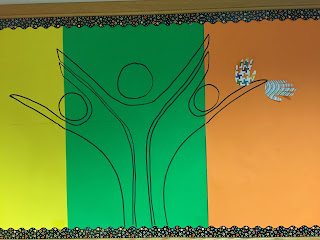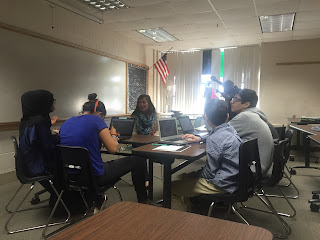With our commitment to personal learning we will continue to analyze our space and ask ourselves, “How does the space reflect the experience we want learners to have?”
One of the most exhausting parts of going back to school is
agonizing over getting one's classroom ready. In the last few years we have been rethinking our classroom to
make the space reflect the experience we want learners to have and it has
proven to be less stressful.
First, we got rid of our oversized, heavy, teacher desk and
filing cabinets. We
replaced the traditional teacher desk with a circular table that would allow
for conferencing with small groups of students. Next, we got rid of our “traditional student” desks (that haven't changed that much since the 1800's) and
replaced them with tables and chairs. We would have loved to do a
combination of high desk tables, "Node Chairs", and other innovative classroom
furniture but it was not in the budget. We were happy to settle for
tables with wheels and chairs that allow for many variations of collaborative
groups.
Think of Walls as Canvas for Learning
|
|
"I notice...wonder...what if"
Canvas Wall
|
Last year we reconsidered our wall space and bulletin boards, after hearing and reading more about personalized learning. Pernille Ripp talks about classrooms being cognitively distracting, affirming our thinking that less is more. The book, The Third Teacher, gave us the idea to think of walls as a canvas. As a result, we removed a bulletin board and some posters from an entire wall so that space became a canvas for learners to draft, question, collaborate, brainstorm, share, draw or whatever else the learning lends itself toward. We still kept our "ideal self" tree and the signature board our learners sign after drafting class norms to create our class culture(see pics below). And while we keep a photo of our families by our computer, we want the learners to see the class is a collective space for all and not just Mrs. Loo's/Mrs. Pettis' classroom, so we keep our knick-knacks at home.
Once The Year Got Started
Another freeing aspect of personalized learning was getting rid of seating charts. Allowing for learners to sit where they choose encourages natural collaboration. If a learner struggles with focusing in their chosen seat, we step in as teachers and help them monitor their choices to ensure learning. Each day we set up the tables so they are conducive to the day's learning targets. Most days, our tables are set up in sections that included teacher seminar (half circle at the front for direct instruction), collaborative groups (grouped in pods), and tables lined along the wall for independent work. During formative work time, learners would choose to sit in the section that allowed them to access and engage with the information at hand.
Kristin Hogan, a personalized learning coach at Westside in Omaha, Nebraska, poses the following question and suggested layouts. The possibilities are numerous even without fancy furniture.
 Kristin was a Math teacher before she became a coach. In her classroom she had the desks set up in pods, numbered with a dry erase markers. Learners would move about the pods based on learning targets for the day. It also allowed for some pods to be working collaboratively, independently or with the teacher.
Kristin was a Math teacher before she became a coach. In her classroom she had the desks set up in pods, numbered with a dry erase markers. Learners would move about the pods based on learning targets for the day. It also allowed for some pods to be working collaboratively, independently or with the teacher.
 |
| For each unit the essential question in posted on this board. |
 |
| Learner's answers to our first essential question on "Growth Mindset" |

 Kristin was a Math teacher before she became a coach. In her classroom she had the desks set up in pods, numbered with a dry erase markers. Learners would move about the pods based on learning targets for the day. It also allowed for some pods to be working collaboratively, independently or with the teacher.
Kristin was a Math teacher before she became a coach. In her classroom she had the desks set up in pods, numbered with a dry erase markers. Learners would move about the pods based on learning targets for the day. It also allowed for some pods to be working collaboratively, independently or with the teacher.  Kristin was a Math teacher before she became a coach. In her classroom she had the desks set up in pods, numbered with a dry erase markers. Learners would move about the pods based on learning targets for the day. It also allowed for some pods to be working collaboratively, independently or with the teacher.
Kristin was a Math teacher before she became a coach. In her classroom she had the desks set up in pods, numbered with a dry erase markers. Learners would move about the pods based on learning targets for the day. It also allowed for some pods to be working collaboratively, independently or with the teacher. 

















No comments:
Post a Comment